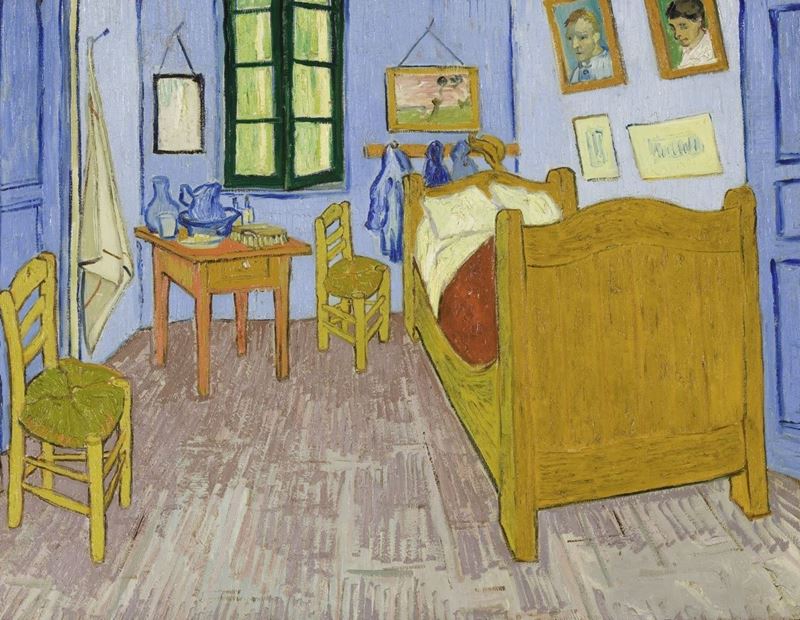Bedroom in Arles - Vincent van Gogh
Van Gogh's Bedroom in Arles, 1889, Oil on canvas, 57.3 x 74 cm, Musée d’Orsay, Paris, France.
After two years in Paris, Vincent van Gogh moved to Arles in southern France on February 20, 1888. He rented a room in the Carrel Hotel-Restaurant where he would stay for three months. In May he moved to a room on the top floor of the Café de la Gare. At the same time, he rented the four-roomed Yellow House in the Lamartine Area and began using it as a workshop He settled entirely in Yellow House in September.
Van Gogh invites his painter friend Gauguin to work together in Arles. Theo van Gogh, who runs a gallery in Paris and sells both his brother's and Gauguin's works, works to fulfill this request. Gauguin agrees to stay with Van Gogh on the condition that Theo's economic assistance continues. Van Gogh prepares Yellow House for Gauguin by doing everything he thinks his friend is comfortable with. He was looking forward to his friend. During this period, his enthusiasm was reflected in his paintings. He paints a lot of pictures adorning the walls of the house and the room of Gauguin. These are the paintings that Van Gogh made in order to demonstrate his artistic talent and which will be the beginning of his rivalry with Gauguin.
Van Gogh wrote the following letter to Theo concerning this painting depicting his bedroom while he was waiting for Gauguin to come:
“My dear Theo,
At last, I’m sending you a little croquis to give you at least an idea of the direction the work is taking. Because today I’ve gone back to it.
My eyes are still tired, but anyway I had a new idea in mind, and here’s the croquis of it. No. 30 canvas once again.
This time it’s simply my bedroom, but the color has to do the job here, and through its being simplified by giving a grander style to things, to be suggestive here of rest or of sleep in general. In short, looking at the painting should rest the mind, or rather, the imagination.
The walls are of pale violet. The floor is of red tiles.
The bedstead and the chairs are fresh butter yellow.
The sheet and the pillows very bright lemon green.
The blanket scarlet red.
The window green.
The dressing table orange, the basin blue.
The doors lilac. And that’s all - nothing in this bedroom, with its shutters, closed.
The solidity of the furniture should also now express unshakeable repose.
Portraits on the wall, and a mirror and a hand-towel and some clothes.
The frame - as there’s no white in the painting - will be white.
This to take my revenge for the enforced rest that I was obliged to take.
I’ll work on it again all day tomorrow, but you can see how simple the idea is. The shadows and cast shadows are removed; it’s colored in flat, plain tints like Japanese prints.
It will contrast, for example, with the Tarascon diligence and the night café.
I won’t write to you at length, because I’m going to start very early tomorrow with the fresh morning light, to finish my canvas.”
To Theo van Gogh. Arles, Tuesday, 16 October 1888.

In this letter, Van Gogh explains his aims in painting. The painting was a reflection of a completely colored feeling. The subject was the bedroom, the motif was rest... But all the items in the bedroom are placed in order to create a strong perspective effect. Half the window is open, sloping furniture, pictures hanging on the walls, it gives an impression as if dangling into the room, this gives the picture a tension. The effect of loneliness and abandonment in the picture outweighs the demands. This unusual perspective practice was not only the conscious personal choice of Van Gogh. The architectural structure of the room was also influential in this. The room had an unusual curvature formed by two walls with 120 and 60-degree angles.
Gauguin came to Arles in October and lived with Van Gogh. It didn't take long for their joint work to cause their distortion. Their close relationship of two months ended when Van Gogh cut his left ear as a result of the crisis. Gauguin left Arles. Van Gogh had voluntarily entered himself at Saint Rémy's Saint-Paul-de-Mausole asylum after he was hospitalized in Arles. When he couldn't take a picture outdoors in the hospital where he spent nearly a year, he either made copies of his own paintings or completed his unfinished paintings. He was doing these studies for his mother or sister.
The first version of "Van Gogh's Bedroom in Arles" was damaged during transportation. At Saint Rémy, he had copied two oil paintings on the same theme. These paintings have two jugs, bottles, and brushes on the table. There is a chair on both sides of the table. The two objects in the picture were interpreted as detecting the arrival of his friend or as a longing for a friend.
In "Van Gogh's Bedroom in Arles", which has three versions, some elements differ from each other. The image that appears here is one of the two copies he made in 1889 in Saint Rémy. With a self-portrait and the portrait of his sister Wil, a Japanese engraver was hung over the head of the bed.
Bibliography;
Walther, I.F., (2005). Van Gogh, Birinci Basım, Taschen/Remzi Kitabevi, İstanbul.
Spence, D., (2015). Büyük Ressamlar Van Gogh, Üçüncü Baskı, Beta Yayınları, İstanbul.
Yetkin, S.K., (2007). Büyük Ressamlar, Birinci Baskı, Palme Yayıncılık, Ankara.
Çev: Kür, P., (2006). Theo'ya Mektuplar, Dördüncü Baskı, Yapı Kredi Yayınları, İstanbul.
Eroğlu, Ö., (2014). Üç Postempresyonist Ruh Cézanne-Van Gogh-Gauguin, Birinci Baskı, Tekhne Yayınlar, İstanbul.
Gombrich, E.H., (2002). Sanatın Öyküsü, Üçüncü Baskı, Remzi Kitabevi, İstanbul.













